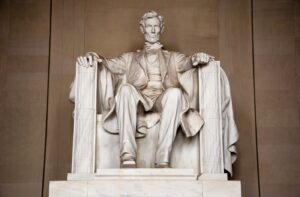“How small, of all that human hearts endure,” Oliver Goldsmith concluded in his philosophical poem The Traveller (1764), “That part which laws and kings can cause or cure.” There is profound truth in these lines, originally written by Goldsmith’s friend Samuel Johnson. Politics is not the most important thing. Yet politics is, still, an important thing. Laws and kings can profoundly aid or hinder the flourishing of human beings in this life. The good of our families, our neighborhoods, and our communities depends on a healthy background culture and society, backed by a well-functioning political regime. Admittedly, this is an abstract ideal that is ever only approximated, never attained, and always in danger of loss.
One central insight of the conservative intellectual movement in the United States after the Second World War is that humanity is not on an upward trajectory toward political perfection. The arc of history does not always bend toward justice. Civilizations rise and fall, and there is nothing inevitable about either. The same can be said for political movements, which have a lifespan of their own and require diligent cultivation and periodic reinvention.
This became painfully evident to conservatives this election cycle, when each major party presidential candidate threatened, in his or her own unique way, to destroy—or at least significantly alter—conservatism as we know it. Old-fashioned conservatives, facing the specter of a Donald Trump or a Hillary Clinton presidency, received a political message this year equivalent to the telegram Hadley Arkes frequently jokes about: “Start worrying. Details to follow.”
American Conservatism and Its Right-Wing Critics
Start your day with Public Discourse
Sign up and get our daily essays sent straight to your inbox.Although the election has now passed, we are still waiting for many of the details. What is clear is that generational and ideological changes, demographic trends, and the decline of traditional religiosity in the United States have made it difficult, if not impossible, to maintain a successful national political coalition around the tenets of postwar conservatism. Economic liberalism (including liberal immigration laws), hawkish foreign policy, and cultural traditionalism have historically been viewed as the three legs of the conservative stool. As George Hawley demonstrates in Right-Wing Critics of American Conservatism, however, being a conservative and being on the right wing of the political spectrum are not necessarily the same thing. In other words, not all of conservatism’s adversaries are in the progressive camp. Many of Donald Trump’s most enthusiastic supporters, for example, dissent from standard conservative orthodoxy on free trade, foreign policy, and immigration.
Hawley’s timely book, written before the rise of Trump, gives a short historical overview of the modern conservative movement. It also highlights, through a series of case studies, several right-wing movements that have stood outside mainstream conservatism in the United States. These groups include localists and front porchers, right-wing secularists, radical libertarians and anarchists, paleoconservatives, and white nationalists.
According to Hawley, what these groups have in common is that, unlike the left, each ranks some value other than equality on “top of the hierarchy of values.” While one could certainly quibble with Hawley’s suggestion that “throughout the world the left advocates universal equality”—there is, after all, a reason we laugh along with Orwell when he writes in Animal Farm that some animals are more equal than others—it is certainly true that the movements Hawley investigates do not prize equality above all else. They are neither progressive nor conservative in the sense in which those terms are used in the United States. They are instead comprised of right-wing critics of American conservativism, part of “a strong tradition of antiprogressive thought in American history that stands completely outside the mainstream conservative movement.”
Defining American Conservatism
One general difficulty with the term “conservative” is that it derives meaning relative to what is being conserved. In the 1980s, for example, the New York Times would describe Communists in the Kremlin working to conserve the Communist regime as conservatives. In the same way, we might talk about the ruling mullahs of Iran or the aristocrats from Downton Abbey as being conservatives, but not at all in the sense in which we use that term in the United States. As Hawley notes, American conservatives “consider themselves the true heirs of the classical liberal tradition exemplified by such thinkers as David Hume, Adam Smith, and John Locke.” What they seek to conserve is liberalism, understood broadly to advance the cause of “limited government, strong traditional families, and strong national defense.”
William F. Buckley gave intellectual coherence to the postwar American conservative movement. “Free-market libertarians, cultural traditionalists, and foreign policy hawks all despised communism,” Hawley observes, “and this mutual loathing helped unite factions that otherwise had little in common.” Through his work at National Review magazine and on the long-running public affairs television show Firing Line, Buckley helped bring these various factions into a unified political coalition. Part of Buckley’s work in journalism was devoted to policing the boundaries of acceptable conservative opinion. In one particularly fascinating chapter, Hawley tells the neglected history of the mainstream conservative movement’s purges of unsavory ideological elements.
Buckley and others publicly criticized and withdrew support from organizations and individuals perceived to be racist or anti-Semitic—such as the anti-communist John Birch Society, the former Klu Klux Klan grand wizard David Duke, and (most recently) the paleoconservative columnist Sam Francis. Without a mainstream national outlet for their views and without support from the Republican Party establishment, Buckley and his movement relegated these individuals to political obscurity. Others, such as the atheist libertarian novelist and playwright Ayn Rand, developed a following outside the orbit of National Review but were never quite welcomed into the inner circle of the modern conservative movement.
George Nash has done more than any other scholar to chronicle the ideological development of modern American conservatism after 1945, and revisiting this history helps make sense of some crucial aspects of our political situation today. Relying on Nash’s 660-page book The Conservative Intellectual Movement in America Since 1945, Hawley provides a useful short introduction to an historical narrative that involves several major characters besides Buckley: Whittaker Chambers, Frank Meyer, Russell Kirk, Harry Jaffa, Irving Kristol, Milton Friedman, and many others contributed in unique ways to the development of the postwar conservative movement. What the movement did, with the help of Buckley’s leadership, was successfully define the ideological boundaries of political conservatism and translate the conservative movement’s broad ideological goals into concrete electoral victories and policy reforms through a political partnership with the leaders of the Republican Party.
The Waning Influence of Movement Conservativism
In light of Buckley’s leadership, consider now the remarkable fact that the February 2016 issue of National Review featured a one-sided symposium with twenty-two different movement leaders explaining why conservatives should reject Trump—and apparently it had no impact at all on the course of the Republican presidential primary. This is at least partly due to the waning influence of the established conservative media outlets in the Internet age. But it also is due to Trump’s ability to connect to those elements of right-wing opinion that had been purged from the respectable journals of conservative thought. These two things are related. Owing to his celebrity status and his use of social media, Trump was able to communicate with large swaths of primary voters without the blessing of the establishment’s gatekeepers. And he spoke to them on their own terms and about their own concerns.
Some of the same figures Buckley and company worked to purge from the conservative movement are coming back in the national political conversation once again. David Duke, buoyed by Trump’s campaign, announced his bid for the open Senate seat in Louisiana, and astoundingly qualified for the statewide debate by polling over 5 percent. Elements of the white nationalist “alt-right” have been vocal Trump supporters, and prominent figures in the politically exiled paleoconservative movement saw in Trump a champion of restrictive immigration policy, economic protectionism, and foreign policy non-interventionism. Electorally, most commentators and analysts thought the Trump campaign had a losing strategy from the start. Trump’s success in the Electoral College depended on white voters without a college degree turning out in force and key groups in Barack Obama’s coalition staying home in equal measure.
Demographics alone tell us that the strategy has an expiration date not too far in the future. Regardless of the coming demographic challenges for the GOP, however, Trump did tap into something that is not simply a function of demographics: popular angst about the economy, jobs, immigration, and foreign policy. Trump did not create the populist forces that drove his campaign, but he was able to ride them to the presidency despite having no early support from any major party establishment figure and being vilified by the highbrow commentariat on both sides of the aisle. In an anti-establishment year, this was his strength.
Some old-guard evangelicals, conservative lawyers, and constitutional originalists did eventually throw their weight behind the campaign, concerned above all else about religious liberty and future appointments to the federal courts. Those concerns were justified, and the dangers are still real. Four or eight years of appointments to the federal courts will fundamentally change the judicial landscape for a generation. The cultural winds are blowing hard against religious liberty, and the courts in a Clinton administration would no longer be—if they ever were—a place of refuge. Trump, of course, is hardly a panacea for this challenge, but there is a chance he will outsource the judicial nomination process to Vice President Pence or another reliable judicial conservative.
Supporting Trump for the sake of the Supreme Court always had an element of the Faustian bargain. Recall that in addition to his promise to appoint conservatives to the Court, he also pledged to build a wall along the southern border and raise a domestic army strong enough to deport thirteen million people, signaled his willingness to torture terrorists and target their families, and showed very little appreciation for the wisdom of constitutionalism and limited government. The best case for Trump always consisted in assuming that he was lying about the promises we didn’t like and telling the truth about the promises we did like. The next four years will be revealing.
What’s Next for Conservatism?
One of the important lessons of George Hawley’s book is that right-wing politics, conservatism, and the Republican Party are not interchangeable. The GOP won big last week, but many conservatives saw no possible path to victory on election night. What should conservatives do now in light of the challenges ahead?
There is no easy fix, but the starting point for national politics must be drastic: a new party, or at least massive rebranding of the Grand Old Party in a way that speaks to the interests and concerns of the white working class but also makes it clear that the Republican Party advances a vision of constitutional government for the purpose of protecting natural rights and affirming our common human dignity. To be morally serious and electorally successful in subsequent elections, the GOP cannot be the party of nativism and racial identity politics.
Russell Moore stated recently in an interview that his top three public policy priorities were the sanctity of human life, religious freedom, and racial reconciliation. To this we could add constitutionalism and economic opportunity (a significant part of which depends on family formation and a healthy marriage culture). We must build a coalition that bridges racial, ethnic, religious, and class lines. This whole project will require a reinvigoration of the conservative intellectual tradition, an engagement with culture and the arts, and the diligent work of the many young, smart policy-oriented conservative reformers working in think tanks and winning offices in state and local governments.
After surveying the demographic and policy challenges facing the right, Hawley cautiously concludes that “it is too early to declare the conservative movement terminally ill.” Tuesday’s election has moved the diagnosis to critical condition.













